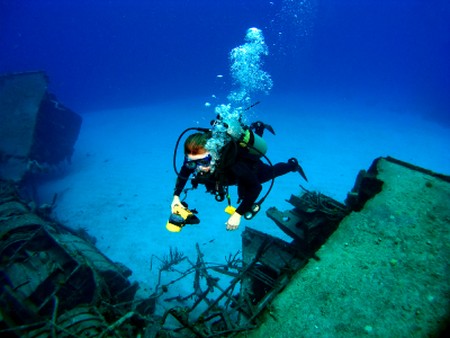Underwater computers
Miniature electronics have revolutionised everyday life and have made their presence felt in the world of diving, too. It’s hard to believe there was a time when divers did not carry computers with them to manage their dives. Divers need to know how long they dive for and to what depths. They need to know how much no-stop diving time they have left (the maximum considered safe for a certain depth), what stops may be needed during an ascent and for how long. They also need to know how fast they are ascending, what is their current depth and what was their maximum depth. Finally, they need to take into consideration the previous dive before planning the next.
Today, the magic of the microchip takes care of all that. A diver simply wears a small unit on the wrist and follows the instructions continuously displayed. A computer is ideal for multilevel diving. It keeps precise track of reducing no-stop times and decompression-stop requirements, whatever the dive profile.
No serious diver should be equipped without a diving computer, and there are many to choose from. Diving computers probably represent the single most important advance in diving equipment since the invention of the aqualung.
Special functions of dive computers Since many technical divers use nitrox (an air mix with increased oxygen and decreased nitrogen), most diving computers can accommodate the extra parameters that nitrox introduces. They take care of maximum operating depths for a given maximum pp02 (partial pressure of oxygen), and track oxygen toxicity, as well as being able to account for the advantage – the increased tolerance to breathing gas at depth.
Some computers can track decompression when a diver uses more than one nitrox mix during a dive, or even uses a part-helium mix instead. There are even computers that can take into account the amount of gas you are breathing and estimate how long the remainder in your tank will last at that depth. Some are connected to your tank by a high-pressure hose, whereas others use a radio transmitter to send messages to a wrist unit.
Miniaturised devices
Many dive computers are only the size of a large watch yet their displays are easy to read. They can be very stylish and conveniently double as an everyday watch.
The microchip brings vast numbers of peripheral functions, too. All manner of alarms and personal preferences can be selected, including the way your decompression is calculated.
Some computers offer a choice of algorithms and others even give the diver the choice of making a deep-stop on the way up from a square-profile dive instead of heading directly for the shallows.
There are a few computers that can be adjusted to work with constant partial pressure of a gas rather than the percentage of oxygen against depth. These are for use by closed-circuit rebreather divers.
Finally, most diving computers allow you to interface with a PC so that you can download your dive information and go over what you did in detail later.
